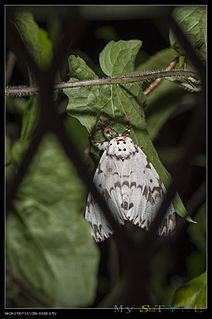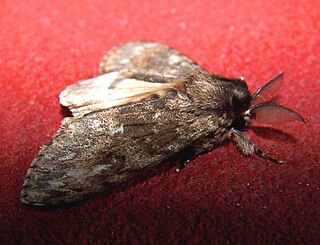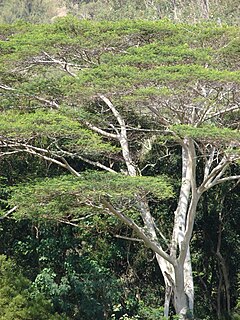
Lymantria dispar, the gypsy moth, is a species of moth in the Erebidae family. Lymantria dispar is subdivided into several subspecies, with subspecies such as L. d. dispar and L. d. japonica being clearly identifiable without ambiguity. Lymantria dispar has been introduced to several continents and is now found in Europe, Africa, Asia, North America and South America. The polyphagous larvae live on a variety of deciduous and coniferous trees and can cause severe damage in years of mass reproduction. Due to these features, the gypsy moth is listed among the world's 100 most invasive alien species.

The black arches or nun moth is a small Palaearctic moth. It is considered a forest pest.

Drepana falcataria, the pebble hook-tip, is a moth of the family Drepanidae. The species was first described by Carl Linnaeus in his 1758 10th edition of Systema Naturae. It is found in Europe, through Siberia to eastern Asia.

Lymantria is a genus of tussock moths in the family Erebidae. They are widely distributed throughout Europe, Japan, India, Sri Lanka, Myanmar, Java, and Celebes. The genus was erected by Jacob Hübner in 1819.
Neachrostia is a genus of moths of the family Erebidae. The genus was erected by George Hampson in 1907.
Hypephyra is a genus of moths in the family Geometridae.

Lymantria mathura, the rosy gypsy moth, is a species of moth of the family Erebidae found in the Russian Far East, Nepal, Japan, the Korean Peninsula, northern India and China. The species was first described by Frederic Moore in 1866.

Lymantria lunata, the luna gypsy moth, is a moth of the family Erebidae. The species was first described by Caspar Stoll in 1782. It is found in Southeast Asia, from India to the northeast coast of Australia.

Lymantria xylina, the casuarina moth or casuarina tussock moth, is a moth in the family Erebidae. The species was first described by Charles Swinhoe in 1903. It is found in Japan, Taiwan and the Chinese provinces of Fujian and Guangdong.

Lymantria dispar asiatica, the Asian gypsy moth, is a moth in the family Erebidae of Eurasian origin. It is similar to Lymantria dispar dispar in appearance, but adult females can fly. It is classified as a pest and is host to over 500 species of trees, shrubs and plants.

Lymantria dispar dispar, commonly known as the gypsy moth, European gypsy moth, or North American gypsy moth, is a moth in the family Erebidae that is of Eurasian origin. It has a range that extends over Europe, Africa, and North America.

Lymantria dispar japonica, commonly known as the Japanese gypsy moth, is a moth in the family Erebidae of Eurasian origin.

Lymantria serva, the ficus tussock moth or serva tussock moth, is a moth in the family Erebidae. It was described by Johan Christian Fabricius in 1793 and is found in Nepal, Sri Lanka, Assam in India and Yunnan in China. It is possibly also found in Taiwan and Hongkong, but these records might be Lymantria iris.

Lymantria grisea is a species of moth of the family Erebidae.
Hypopyra pudens is a moth of the family Erebidae. It is found in Japan, India (Hindustan), Thailand, Vietnam, Singapore, Taiwan, Borneo, Sumatra and Sulawesi. The habitat ranges from lowland areas, including disturbed and coastal areas, up to 1,618 meters.

Falcataria moluccana, commonly known as the Moluccan albizia, is a species of fast-growing tree in the legume family, Fabaceae. It is native to the Maluku Islands, New Guinea Island, the Bismarck Archipelago, and the Solomon Islands. It is cultivated for timber throughout South Asian and Southeast Asian countries. This tree is considered to be invasive in Hawaii, American Samoa and several other island nations in the Pacific and Indian Oceans. It is about 30m tall tree in nature with a massive trunk and an open crown.
Lymantria marginata is a moth of the family Erebidae first described by Francis Walker in 1855. It is found in India, Bangladesh, Sri Lanka and Thailand.
Lymantria subrosea is a moth of the family Erebidae first described by Francis Walker in 1855. It is found from Sri Lanka to China and Sundaland, the Philippines, Sulawesi, Seram, the Lesser Sundas to Timor. The Sumatran population is categorized under the subspecies, Lymantria subrosea singapura.

Cleora alienaria is a moth of the family Geometridae first described by Francis Walker in 1860. It is found in Sri Lanka, the Indian subregion to the Andaman Islands, Thailand, Sundaland, Taiwan, and Lesser Sundas as far east as Timor and Christmas Island.














